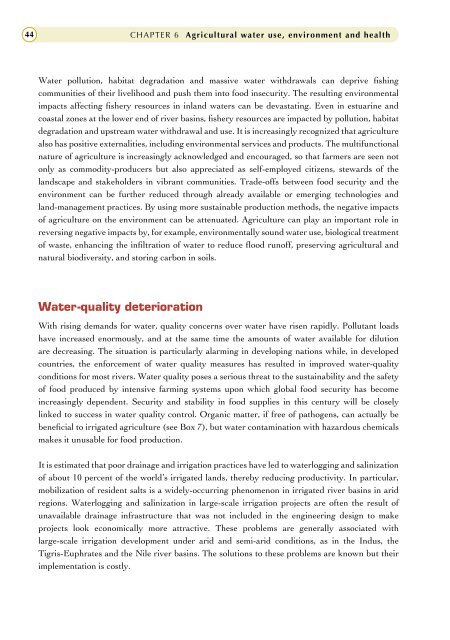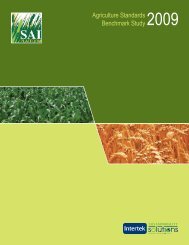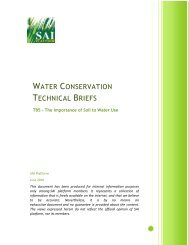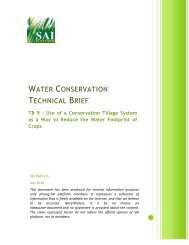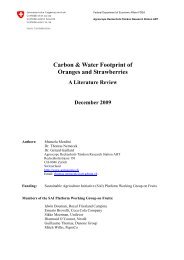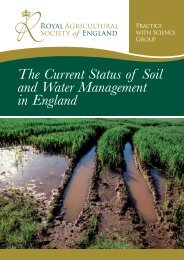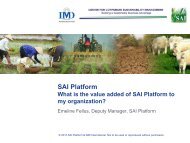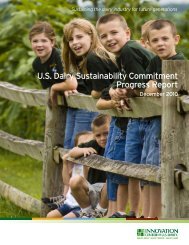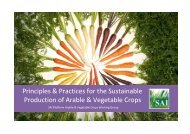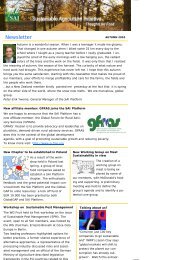Agriculture, food and water - FAO.org
Agriculture, food and water - FAO.org
Agriculture, food and water - FAO.org
Create successful ePaper yourself
Turn your PDF publications into a flip-book with our unique Google optimized e-Paper software.
44 CHAPTER 6 Agricultural <strong>water</strong> use, environment <strong>and</strong> health<br />
Water pollution, habitat degradation <strong>and</strong> massive <strong>water</strong> withdrawals can deprive fishing<br />
communities of their livelihood <strong>and</strong> push them into <strong>food</strong> insecurity. The resulting environmental<br />
impacts affecting fishery resources in inl<strong>and</strong> <strong>water</strong>s can be devastating. Even in estuarine <strong>and</strong><br />
coastal zones at the lower end of river basins, fishery resources are impacted by pollution, habitat<br />
degradation <strong>and</strong> upstream <strong>water</strong> withdrawal <strong>and</strong> use. It is increasingly recognized that agriculture<br />
also has positive externalities, including environmental services <strong>and</strong> products. The multifunctional<br />
nature of agriculture is increasingly acknowledged <strong>and</strong> encouraged, so that farmers are seen not<br />
only as commodity-producers but also appreciated as self-employed citizens, stewards of the<br />
l<strong>and</strong>scape <strong>and</strong> stakeholders in vibrant communities. Trade-offs between <strong>food</strong> security <strong>and</strong> the<br />
environment can be further reduced through already available or emerging technologies <strong>and</strong><br />
l<strong>and</strong>-management practices. By using more sustainable production methods, the negative impacts<br />
of agriculture on the environment can be attenuated. <strong>Agriculture</strong> can play an important role in<br />
reversing negative impacts by, for example, environmentally sound <strong>water</strong> use, biological treatment<br />
of waste, enhancing the infiltration of <strong>water</strong> to reduce flood runoff, preserving agricultural <strong>and</strong><br />
natural biodiversity, <strong>and</strong> storing carbon in soils.<br />
Water-quality deterioration<br />
With rising dem<strong>and</strong>s for <strong>water</strong>, quality concerns over <strong>water</strong> have risen rapidly. Pollutant loads<br />
have increased enormously, <strong>and</strong> at the same time the amounts of <strong>water</strong> available for dilution<br />
are decreasing. The situation is particularly alarming in developing nations while, in developed<br />
countries, the enforcement of <strong>water</strong> quality measures has resulted in improved <strong>water</strong>-quality<br />
conditions for most rivers. Water quality poses a serious threat to the sustainability <strong>and</strong> the safety<br />
of <strong>food</strong> produced by intensive farming systems upon which global <strong>food</strong> security has become<br />
increasingly dependent. Security <strong>and</strong> stability in <strong>food</strong> supplies in this century will be closely<br />
linked to success in <strong>water</strong> quality control. Organic matter, if free of pathogens, can actually be<br />
beneficial to irrigated agriculture (see Box 7), but <strong>water</strong> contamination with hazardous chemicals<br />
makes it unusable for <strong>food</strong> production.<br />
It is estimated that poor drainage <strong>and</strong> irrigation practices have led to <strong>water</strong>logging <strong>and</strong> salinization<br />
of about 10 percent of the world’s irrigated l<strong>and</strong>s, thereby reducing productivity. In particular,<br />
mobilization of resident salts is a widely-occurring phenomenon in irrigated river basins in arid<br />
regions. Waterlogging <strong>and</strong> salinization in large-scale irrigation projects are often the result of<br />
unavailable drainage infrastructure that was not included in the engineering design to make<br />
projects look economically more attractive. These problems are generally associated with<br />
large-scale irrigation development under arid <strong>and</strong> semi-arid conditions, as in the Indus, the<br />
Tigris-Euphrates <strong>and</strong> the Nile river basins. The solutions to these problems are known but their<br />
implementation is costly.


